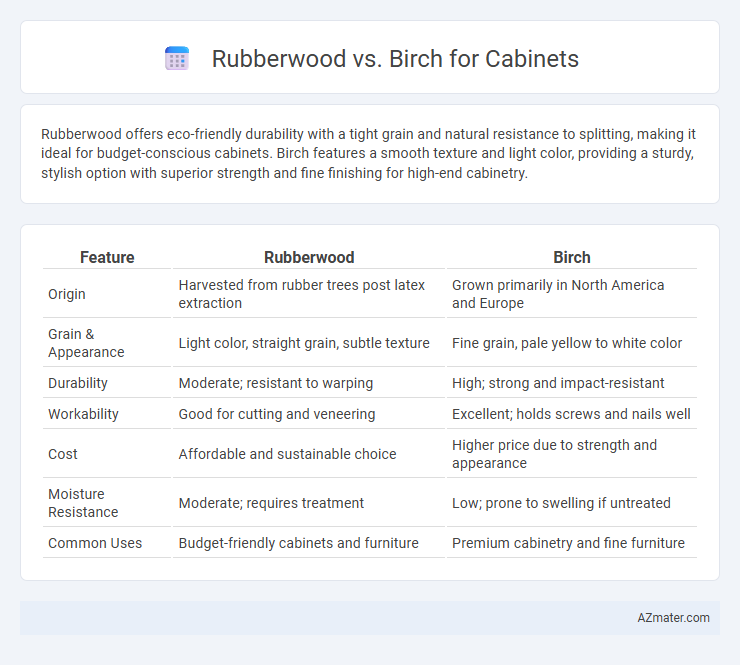Rubberwood offers eco-friendly durability with a tight grain and natural resistance to splitting, making it ideal for budget-conscious cabinets. Birch features a smooth texture and light color, providing a sturdy, stylish option with superior strength and fine finishing for high-end cabinetry.
Table of Comparison
| Feature | Rubberwood | Birch |
|---|---|---|
| Origin | Harvested from rubber trees post latex extraction | Grown primarily in North America and Europe |
| Grain & Appearance | Light color, straight grain, subtle texture | Fine grain, pale yellow to white color |
| Durability | Moderate; resistant to warping | High; strong and impact-resistant |
| Workability | Good for cutting and veneering | Excellent; holds screws and nails well |
| Cost | Affordable and sustainable choice | Higher price due to strength and appearance |
| Moisture Resistance | Moderate; requires treatment | Low; prone to swelling if untreated |
| Common Uses | Budget-friendly cabinets and furniture | Premium cabinetry and fine furniture |
Introduction to Rubberwood and Birch
Rubberwood, derived from parawood trees primarily cultivated in Southeast Asia, offers a sustainable and eco-friendly option for cabinetry due to its fast growth and availability as a byproduct of rubber production. Birch, native to North America and Europe, is valued for its fine grain, smooth texture, and strong durability, making it a popular choice for high-quality cabinet construction. Both woods provide distinct aesthetic and structural properties, with rubberwood known for its light color and resistance to warping, while birch delivers a warm, creamy tone and excellent workability.
Overview of Rubberwood as a Cabinet Material
Rubberwood, harvested from the Para rubber tree (Hevea brasiliensis), is a sustainable and eco-friendly choice for cabinetry due to its fast growth and abundant availability. It features a light color with a straight grain, offering excellent workability and resistance to warping, making it ideal for kitchen and bathroom cabinets. Its moderate hardness and smooth finish provide durability and a versatile surface suitable for staining or painting.
Birch Wood Characteristics for Cabinetry
Birch wood offers a fine, uniform texture and exceptional strength, making it an ideal choice for cabinetry that requires durability and a smooth finish. Its light color and subtle grain patterns provide a versatile, modern aesthetic that easily adapts to different staining and painting techniques. Birch's resistance to wear and its stability in varying humidity conditions ensure long-lasting performance in kitchen and bathroom cabinets.
Durability Comparison: Rubberwood vs Birch
Rubberwood offers moderate durability with resistance to warping and insect damage, making it suitable for budget-friendly cabinets. Birch provides higher durability due to its dense grain structure and excellent resistance to dents and scratches, ideal for long-lasting cabinetry. Both hardwoods perform well, but birch excels in wear resistance and longevity.
Aesthetic Differences: Color, Grain, and Finish
Rubberwood features a light cream to pale yellow color with a subtle, straight grain that lends a clean and modern aesthetic to cabinets, often finished with clear varnish to highlight its smooth texture. Birch offers a warmer, more reddish-brown hue with a tight and fine grain pattern, providing a richer and more traditional look ideal for classic cabinetry. The finish on birch typically enhances its natural warmth and can range from matte to glossy, creating a visually appealing depth that contrasts with rubberwood's more neutral and contemporary appearance.
Cost Analysis: Rubberwood vs Birch Cabinets
Rubberwood cabinets generally offer a more affordable cost option due to the wood's widespread availability and faster growth cycle compared to birch. Birch cabinets tend to be more expensive because of the wood's durability, fine grain, and higher market demand in premium cabinetry. Budget-conscious remodeling projects often favor rubberwood for its cost-effectiveness without significantly compromising quality or appearance.
Environmental Impact and Sustainability
Rubberwood, sourced from rubber trees after latex production, is highly sustainable due to its renewable lifecycle and waste reduction benefits compared to birch, which typically comes from slower-growing hardwood forests. The environmental impact of rubberwood is lower because it utilizes plantation trees that would otherwise be discarded, while birch harvesting often leads to greater deforestation and habitat disruption. Choosing rubberwood for cabinets supports sustainable forestry practices and reduces the carbon footprint associated with wood furniture production.
Maintenance and Longevity
Rubberwood cabinets offer natural resistance to moisture and pests, making them easier to maintain and less prone to warping over time compared to birch. Birch wood requires regular sealing and more frequent upkeep to prevent damage from humidity and wear. Rubberwood's durability and low maintenance extend cabinet longevity, often surpassing birch in sustained performance.
Best Applications for Each Wood Type
Rubberwood offers excellent moisture resistance and durability, making it ideal for kitchen cabinets and bathroom vanities where exposure to humidity is frequent. Birch features a fine, uniform grain that provides a smooth finish, making it perfect for intricate cabinet designs and painted surfaces in living rooms or offices. Choosing Rubberwood supports eco-friendly practices due to its sustainable harvesting from rubber trees post-latex production, while Birch delivers superior hardness and stability for high-traffic cabinetry areas.
Which Is Better for Cabinets: Rubberwood or Birch?
Rubberwood offers excellent durability and resistance to warping, making it a cost-effective choice for cabinets with a smooth finish ideal for painted surfaces. Birch is prized for its fine grain and strength, providing a more refined and natural wood appearance that holds stains beautifully, making it ideal for visible wooden cabinetry. For heavy-use cabinets requiring both toughness and aesthetic appeal, birch generally outperforms rubberwood in longevity and visual quality.

Infographic: Rubberwood vs Birch for Cabinet
 azmater.com
azmater.com